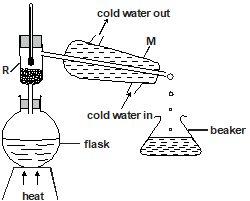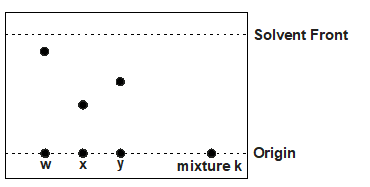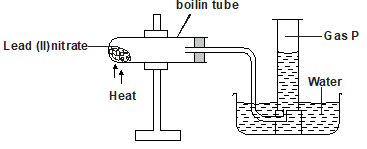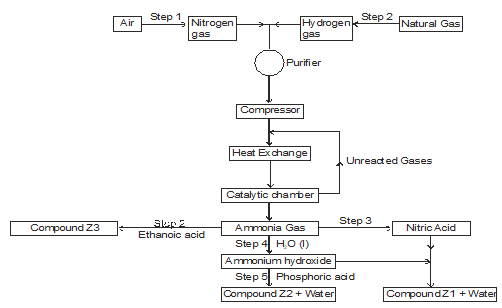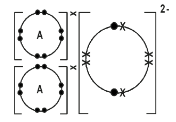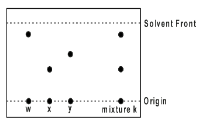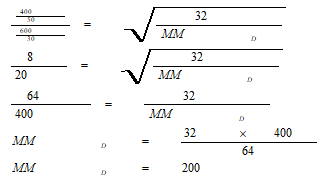QUESTIONS
- A student separated liquid P (B.P 78°C) and liquid Q (B.P 100°C) wring the apparatus shown below.
- Name the apparatus labelled
- M (1 mark)
- R (1 mark)
- State one function of the glass bead in apparatus labelled R (1 mark)
- What is the reading on the thermometer when the first jar drops of the distillate appeared in the beaker.(1 mark)
- Which of the liquids remains in the flask.(1 mark)
- Name the apparatus labelled
- Name a method that can be used to extract the following:-
- Common salt from a salt solution.(1 mark)
- Paraffin from crude oil.(1 mark)
- A compound of carbon, hydrogen and oxygen contain 54.55% carbon, 9.09% and remaining 36.36% oxygen. If its relative molecular mass is 88, determine its molecular formula(C=12.0, H =1.0, O= 16.0) [4mark]
- Sodium nitrate can also be used to prepare nitric(V)acid. State two reasons why potassium nitrate is preferred over Sodium nitrate. (2marks)
- The atomic number of an element A is 11 and that of B to 8.
- Write down a possible formula of compounded formed between A and B(1mark)
- Draw a dot (•) and cross (×) diagram to show bonding in compound farmed. (2 marks)
-
- Below is a paper chromatogram of pure substances W, X and Y
- The mixture K contains substances W and X only. Indicate on the diagram the chromatogram of K.(2 marks)
- State one application of chromatography.(1 mark)
- Below is a paper chromatogram of pure substances W, X and Y
- Study the set up below and use it to answer the questions that follow.
- What observations are made in the boiling tube. Explain.(1 mark)
- Write an equation of reaction occurring in the boiling tube.(1 mark)
- When excess dilute hydrochloric acid was added to sodium sulphate, 960cm³ of sulphuric (IV) oxide gas was produced. Calculate the mass of sodium sulphite that was used. (Molar mass of sodium sulphite = 126g) and molar gas volume at rtp is 24dm³.(3 marks)
- The table below shows atomic and ionic radii of some elements represented by letters U, V, W, X (Not the actual symbols) Study it and answer the questions that follow.
Element Atomic Radius (nm) Ionic radius (nm) U 0.174 0.099 V 0.203 0.133 W 0.099 0.181 X 0.136 0.065 - Classify element X as a metal or non-metal. Explain. (1 mark)
- Which of the elements is the strongest reducing agent? (1 mark)
- Which element forms an anion.(1 mark)
-
- State Graham’s law of diffusion.(1 mark)
- 400cm3 of gas D diffuses from porous plug in 50 seconds while 600cm3 of oxygen diffuses from the same porous plant in 30 seconds. Calculate the relative molecular mass of gas. (O = 16)(3 marks)
- The flow chart below shows the industrial preparation of ammonia and process used in the manufacture of ammonium compounds. Study it and answer the questions that follow.
- Give the name of the:
- Process in step 1 (1 mark)
- Reaction that takes place in step 5 (1 mark)
-
- State one other source of hydrogen gas apart from natural gas. (1 mark)
- Explain why it is necessary to compress nitrogen and hydrogen in this process.(2 marks)
-
- Write an equation for the reaction which takes place in step 2(1 mark)
- Name the catalyst and the reagents used in step 3.
- Catalyst (1 mark)
- Reagents (1 mark)
- Name compound Z1 (1 mark)
- Give one commercial use of compound Z2 (1 mark)
- Give the name of the:
- Starting with zinc metal, describe how a solid sample of zinc hydroxide can prepared.(3 marks)
- The substances and apparatus below were used to test the presence of nitrate in substance D.
- Identify substance D (1 mark)
- What are the components of the brown ring.(1 mark)
-
- Nitrogen does not support combustion yet burning magnesium introduced into a gas jar of nitrogen continues to burn, forming a white solid. Explain.(1 mark)
- Write an equation for the reaction forming the white solid.(1 mark)
- State two uses of nitrogen.(1 mark)
- Study the flow chart below and answer the questions that follow.
Identify- Solution K.(1 mark)
- Solid L(1 mark)
- gas M ( 1 mk)
MARKING SCHEME
- A student separated liquid P (B.P 78°C) and liquid Q (B.P 100°C) wring the apparatus shown below.
- Name the apparatus labelled
-
- M (1 mark)
- liebig condenser
- R (1 mark)
- Fractionating column
- M (1 mark)
- State one function of the glass bead in apparatus labelled R (1 mark)
- To increase surface area for condensation
- What is the reading on the thermometer when the first jar drops of the distillate appeared in the beaker.(1 mark)
- 78
- Which of the liquids remains in the flask.(1 mark)
- water
- Name a method that can be used to extract the following:-
- Common salt from a salt solution.(1 mark)
- evaporation
- Paraffin from crude oil.(1 mark)
- Fractional distillation
- Common salt from a salt solution.(1 mark)
- A compound of carbon, hydrogen and oxygen contain 54.55% carbon, 9.09% and remaining 36.36% oxygen. If its relative molecular mass is 88, determine its molecular formula(C=12.0, H =1.0, O= 16.0) [4mark]
Empirical formula is C2H4OElement
Carbon
Hydrogen
Oxygen
Symbol
C
H
O
Moles present = % composition
Molar mass54.55
129.09
136.36
16Divide by the smallest value
4.5458
2.27259.09
2.27252.2725
2.2725Mole ratios
2
4
1
The molecular formula is thus determined :
n = Relative formular mass = 88 = 2
Relative empirical formula 44
The molecular formula is (C2H4O ) x 2 = C4H8O2. - Sodium nitrate(V)can also be used to prepare nitric(V)acid. State two reasons why potassium nitrate(V) is preferred over Sodium nitrate(V). (2marks)
- Potassium nitrate(V) is more volatile than sodium nitrate(V) and therefore readily displaced from the less volatile concentrated sulphuric(VI)acid
- Sodium nitrate(V) is hygroscopic and thus absorb water . Concentrated sulphuric(VI)acid dissolves in water. The dissolution is a highly exothermic process
- The atomic number of an element A is 11 and that of B to 8.
- Write down a possible formula of compounded formed between A and B(1mark)
- A2B
- Draw a dot (•) and cross (×) diagram to show bonding in compound farmed. (2 marks)
- Write down a possible formula of compounded formed between A and B(1mark)
- Below is a paper chromatogram of pure substances W, X and Y
- The mixture K contains substances W and X only. Indicate on the diagram the chromatogram of K.(2 marks)
- State one application of chromatography.(1 mark)
- Testing of illegal drugs in urine
- The mixture K contains substances W and X only. Indicate on the diagram the chromatogram of K.(2 marks)
- Study the set up below and use it to answer the questions that follow.
- What observations are made in the boiling tube. Explain.(1 mark)
- Red residue cooled to a yellow residue
- Brown fumes produced
- Write an equation of reaction occurring in the boiling tube.(1 mark)
2Pb(NO3)22PbO(s) + 4NO2(g) + O2(g)
- What observations are made in the boiling tube. Explain.(1 mark)
- When excess dilute hydrochloric acid was added to sodium sulphate, 960cm³ of sulphuric (IV) oxide gas was produced. Calculate the mass of sodium sulphite that was used. (Molar mass of sodium sulphite = 126g) and molar gas volume at rtp is 24dm³.(3 marks)
Na2SO3(s) + 2HCL(aq) → 2NaCl(aq) + SO2(s) + 2H2O(l)
1 mole 1 Mole
Moles of SO2 = 0.96 = 0.04
24
Mole ratio 1 : 1 ✓½
Moles of Na2SO3 = 0.04 ✓½
RMM of Na2SO3 = 126
Mass of Na2SO3 = 0.04 × 126 ✓½
= 5.04 g ✓ - The table below shows atomic and ionic radii of some elements represented by letters U, V, W, X (Not the actual symbols) Study it and answer the questions that follow.
- Classify element X as a metal or non-metal. Explain. (1 mark)
- Its a metal½ since atomic radius is greater✓½ than ionic radius
- Which of the elements is the strongest reducing agent? (1 mark)
- V
- Which element forms an anion.(1 mark)
- W
- Classify element X as a metal or non-metal. Explain. (1 mark)
-
- State Graham’s law of diffusion.(1 mark)
- The rate of diffusion of a gas is inversely proportional to the square root of its density provided the initial conditions remain constant
- 400cm3 of gas D diffuses from porous plug in 50 seconds while 600cm3 of oxygen diffuses from the same porous plant in 30 seconds. Calculate the relative molecular mass of gas. (O = 16)(3 marks)
- State Graham’s law of diffusion.(1 mark)
- The flow chart below shows the industrial preparation of ammonia and process used in the manufacture of ammonium compounds. Study it and answer the questions that follow.
- Give the name of the:
- Process in step 1(1 mark)
- Fractional distillation
- Reaction that takes place in step 5 (1 mark)
- neutralization
- Process in step 1(1 mark)
-
- State one other source of hydrogen gas apart from natural gas. (1 mark)
- Cracking of long chain alkanes
- Explain why it is necessary to compress nitrogen and hydrogen in this process. (2 marks)
- High pressure brings the molecules closer/increasing the concentration of gas molecules/the pressure shifts the equilibrium the right; Hence the yield of ammonia increases
- State one other source of hydrogen gas apart from natural gas. (1 mark)
-
- Write an equation for the reaction which takes place in step 2(1 mark)
NH3(g) + CH3COOH(aq) → CH3CHOONH4 - Name the catalyst and the reagents used in step 3.
- Catalyst- Platinum rhodium /platinum (1 mark)
- Reagents - Water and oxygen (1 mark)
- Write an equation for the reaction which takes place in step 2(1 mark)
- Name compound Z1(1 mark)
- Ammonium nitrate; rej Formula
- Give one commercial use of compound Z2 (1 mark)
- as fertilizer; rej manufacture of fertilizer;✓1
- Give the name of the:
- Starting with zinc metal, describe how a solid sample of zinc hydroxide can prepared.(3 marks)
- To nitric acid add excess zinc metal, filter to remove excess zinc. Add sodium hydroxide to zinc nitrate solution.
- A precipitation reaction will occur where zinc hydroxide will be precipitated out. Filter to obtain zinc hydroxide as the residue and dry it between filter paper.
- The substances and apparatus below were used to test the presence of nitrate in substance D.
- Identify substance D (1 mark)
- Concentrated sulphuric acid
- What are the components of the brown ring.(1 mark)
- Iron (II) sulphate-nitrogen (II) oxide complex
- Identify substance D (1 mark)
-
- Nitrogen does not support combustion yet burning magnesium introduced into a gas jar of nitrogen continues to burn, forming a white solid. Explain.(1 mark)
- Burning magnesium produce a lot of heat capable of breaking triple bond holding nitrogen atoms together
- Write an equation for the reaction forming the white solid.(1 mark)
Mg + N2 → Mg3N2 - State two uses of nitrogen.(1 mark)
- Haber process
- Manufacture of nitrogenous fertilizer
- Nitrogen does not support combustion yet burning magnesium introduced into a gas jar of nitrogen continues to burn, forming a white solid. Explain.(1 mark)
- Study the flow chart below and answer the questions that follow.
Identify- Solution K.(1 mark)
- Nitric acid
- Solid L(1 mark)
- PbO
- gas M ( 1 mk)
- Oxygen gas
- Solution K.(1 mark)
Download Chemistry Questions and Answers - Form 3 Mid Term 2 Exams 2023.
Tap Here to Download for 50/-
Get on WhatsApp for 50/-
Why download?
- ✔ To read offline at any time.
- ✔ To Print at your convenience
- ✔ Share Easily with Friends / Students

